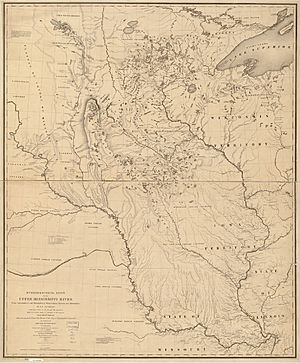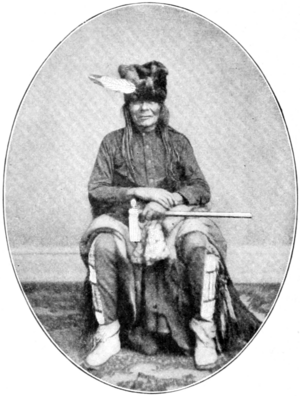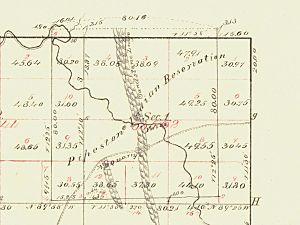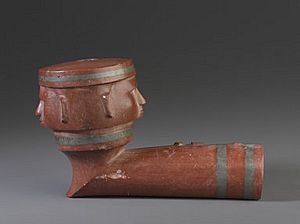Yankton Sioux Tribe facts for kids
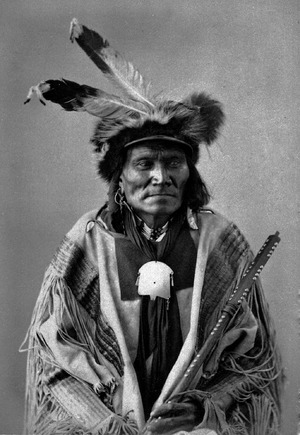
Long Fox, To-Can-Has-Ka,
Tachana, Yankton Sioux, 1872 |
|
| Total population | |
|---|---|
| 11,594 enrolled members | |
| Regions with significant populations | |
| Languages | |
| Dakota, English | |
| Religion | |
| traditional tribal religion, Sun Dance, Native American Church, Christianity |
|
| Related ethnic groups | |
| other Eastern Dakota, Western Dakota people |
The Yankton Sioux Tribe of South Dakota is a Native American tribe. They are part of the Yankton group, located in South Dakota. Their name in the Dakota language is Ihaƞktoƞwaƞ Dakota Oyate. This means "People of the End Village." This name comes from a time when the tribe lived near Spirit Lake.
Historically, the Yankton Sioux Tribe was known as the protectors of the sacred Pipestone Quarry. This quarry is a very important place for the Oceti Sakowin (Dakota/Sioux) people. Sometimes, the Yankton people are called "Western Sioux" or "Middle Sioux."
The tribe also takes care of a herd of wild bison.
Contents
Exploring with Lewis & Clark
There is a local story about the famous explorers Meriwether Lewis and William Clark. In August 1804, they were exploring what is now southeastern South Dakota. The story says that when Lewis heard a baby boy was born nearby, he visited the child. He supposedly wrapped the baby in an American flag and declared him an American. This baby grew up to be a leader of the Yankton Sioux, known as Struck By-the-Ree. However, the explorers' own journals do not mention this event.
Land Treaties and Changes
By the late 1850s, many people wanted to settle in southeastern South Dakota. This created a lot of pressure on the Yankton Sioux. In late 1857, Chief Struck-by-the-Ree and other leaders traveled to Washington, D.C. They went to discuss a treaty with the United States government.
For over three months, they worked on the terms of a land cession treaty. This means they talked about giving up some of their land. The Treaty of Washington was signed on April 19, 1858.
When Chief Struck-by-the-Ree returned, he told his people: "The white men are coming in like maggots. It is useless to resist them. They are many more than we are. We could not hope to stop them." He explained that fighting would lead to many deaths. He urged his people to accept the situation and get the best terms they could.
The 1858 Treaty Details
The treaty involved about 11.5 million acres of land. In return, the tribe was promised about $1.6 million in payments over 50 years. These payments are called "annuities." The treaty also included plans to help the tribe learn farming, industrial skills, and homemaking.
This agreement moved the tribe to a 475,000-acre reservation. This new land was on the north side of the Missouri River. It is now in Charles Mix County, South Dakota. The U.S. Senate approved the treaty in February 1859. President James Buchanan then made it official. On July 10, 1859, the Yankton Sioux moved to their new reservation.
Life on the Reservation
The tribe's official land is called the Yankton Indian Reservation. It was set up in 1853 in Charles Mix County, South Dakota. The reservation covers 36,741 acres. Most of the tribe moved to this reservation in the 1860s.
Building the Economy
The Yankton Sioux Tribe works to create jobs and opportunities for its members. They own and run the Fort Randall Casino and Hotel in Pickstown, South Dakota. They also operate the Lucky Lounge and Four Directions Restaurant.
Other important employers on the reservation include Indian Health Services, the tribal government itself, the Bureau of Indian Affairs, and the Marty Indian School.
Famous Tribal Members
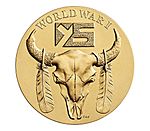
Many notable people are members of the Yankton Sioux Tribe. They have made important contributions in different fields:
- Indigenous (band) – A popular music group.
- Ella Cara Deloria – A linguist and ethnologist who studied Native American languages and cultures.
- Rev. Philip Joseph Deloria – The first Episcopal priest from his people.
- Jacqueline Keeler – A writer and activist.
- Maria Pearson – An activist known as the "Rosa Parks of NAGPRA" for her work on Native American graves and cultural items.
- Paul Rouse Sr. – A recognized Chief.
- Jimmy Sanchez – A martial artist and motivational speaker.
- Faith Spotted Eagle – An elder, activist, and the first Native American to receive an electoral vote for president.
- Struck by the Ree – A respected Chief and treaty signer.
- Greg Zephier Sr. – An activist, artist, and musician.
- Zitkala-Sa – A writer, editor, musician, teacher, and political activist.
- Nathan Neuharth – An author.


